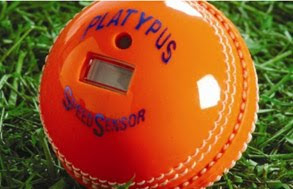Cricket ball that measures its own speed
Wednesday, January 13, 2010 - - 0 Comments

In the game of cricket, the express bowler holds a special place – the fastest of the fast deliver the ball at around 100mph – it’s scary to watch, because at those speeds, 5.75 ounces (163 g) of leather and cork can kill you and rearing fast balls aimed at the throat are a commonly used method of unsettling the batsman.
In most English-speaking countries, the names of the fastest, most intimidating bowlers down the years have become part of common knowedge - Harold Larwood, Typhoon Tyson, Wes Hall, Jeff Thomson, and more recently, Shoiab Akhtar and Brett Lee. Since the first radar guns were used to measure ball speed, the public has been fascinated with the ongoing quest to be labelled the “fastest bowler in the world” fought out between Lee and Akhtar. Now you no longer need a radar gun to get an accurate reading of your speed with a new cricket ball produced that puts the measuring technology inside the ball so any budding Brett Lee can work on their speed.
Stand at square leg or point (at 90 degrees to the direction of travel of the ball) when Brett Lee bowls, and you’ll see the slips fieldsmen waiting for a snick are most of the way back to the fence. When the ball leaves the bowlers hand, it is travelling at its fastest – then aerodynamic drag slows it down until it bounces, which slows it down further, and then it travels onwards, slowing further until it reaches the wicketkeeper’s gloves. By the time the ball has reached the batsman, the speed of the ball has dropped by at least 10% compared to the point at which it has just left the bowler’s hand.
The AUD$55 (U.S.45) Speedsensor by Kookaburra is the official size, shape and weight of a standard cricketball, with a small LCD readout on one face. What makes it special is its ability to sense and display the speed the cricketball has been bowled.
Radar guns seek a reading in the area between the point the ball leaves the bowler’s hand and strikes the pitch, where the ball is travelling fastest. The Speedsensor measures speed by measuring the time between the bowler’s hand and when it hits something (the pitch or the nets, or that all-purpose, readily-available wicket, the trash can.
There’s only one catch – you must program in how far the object is away before you bowl it. This is difficult if you’re aiming at a cricket pitch, because pitching it beyond the target, say 10 metre mark, by one metre will give you a 10% slower speed.
The manufacturers claim the ball is very accurate if the distance is exact, but warned against hitting the ball with a bat or anything other than a motionless object. If you’re aiming to measure speed, Kookaburra told us that they recommend bowling in the nets and covering the wire netting with a blanket to avoid damaging the ball. Mark out the point at which you will let go of the ball exactly the distance you program into the ball, and you should be right to get a good reading.
Speed measurement was one of the first applications of new technology for television broadcast enhancement and bowling speeds have been well documented since then.
Shoaib Akhtar of Pakistan sent down the fastest delivery ever recorded in cricket: a 161.3 Kph or 100.2 mph. Akhtar was also the first person to break the 100 mph mark in New Zealand on April 27, 2002 when he nudged through the 100 miles-per hour (160.9344kph) barrier with a ball registering 161 km/h. (MD)
This entry was posted on 9:00 AM
You can follow any responses to this entry through
the RSS 2.0 feed.
You can leave a response,
or trackback from your own site.
0 comments:
Post a Comment